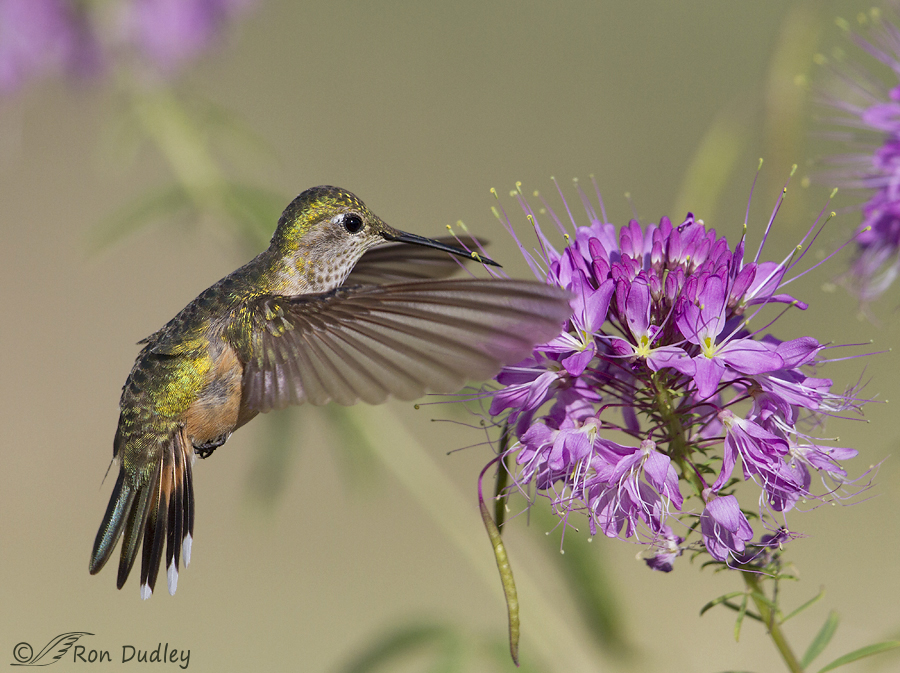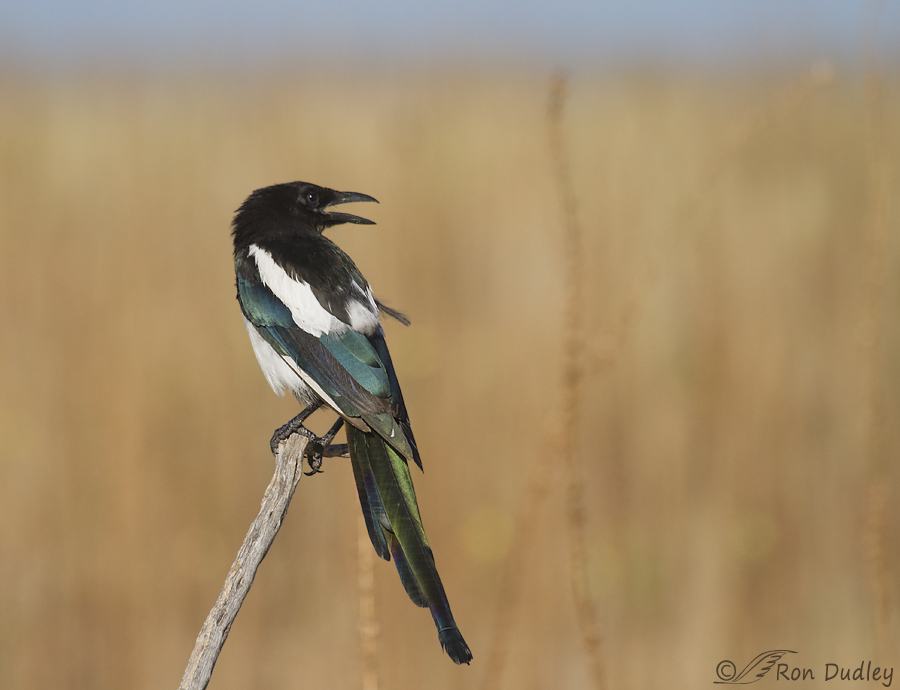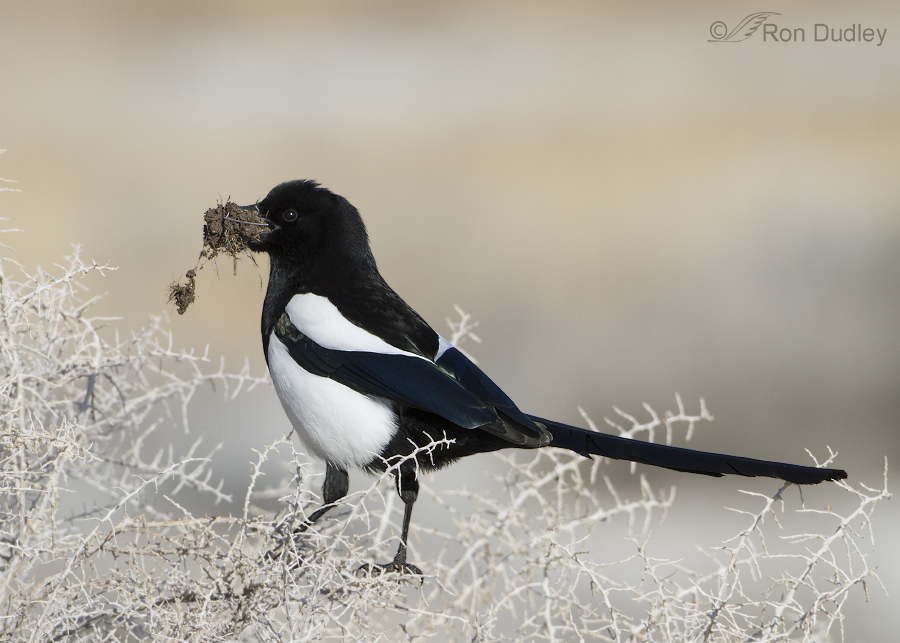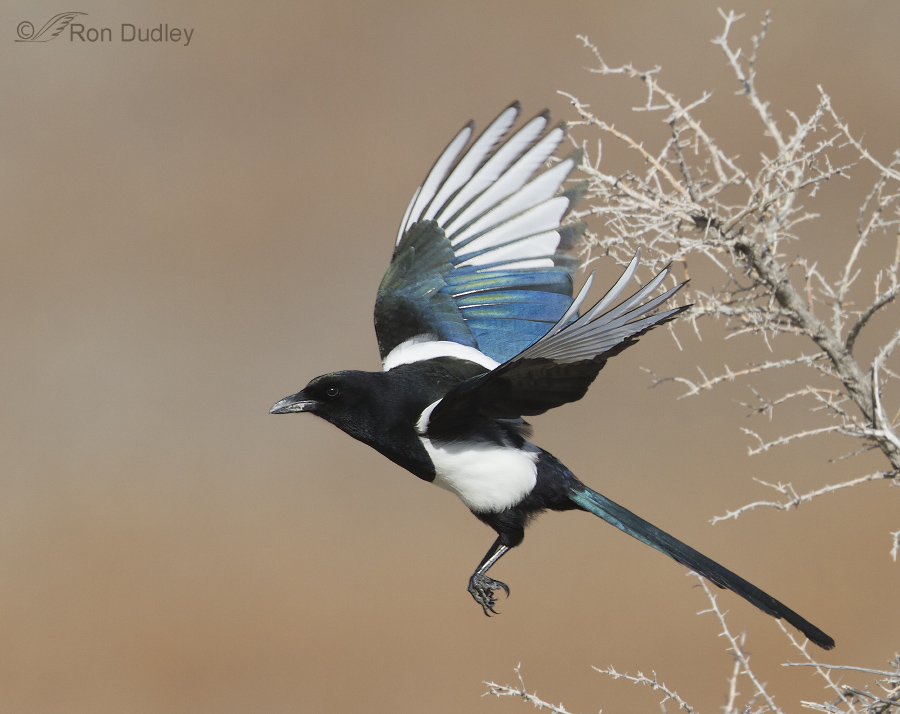Tag: iridescence
Iridescence And The Role of Plumage Variations In Juvenile Magpies
Structural Colors In Birds – Black-billed Magpie
Black-billed Magpie Just After Take-off
Each spring I spend time photographing magpies on Antelope Island. Not many images of them are keepers but this is one I like.
It Must Be Spring – Magpies Are Beginning Nest-building
Magpie With Nesting Material In Flight
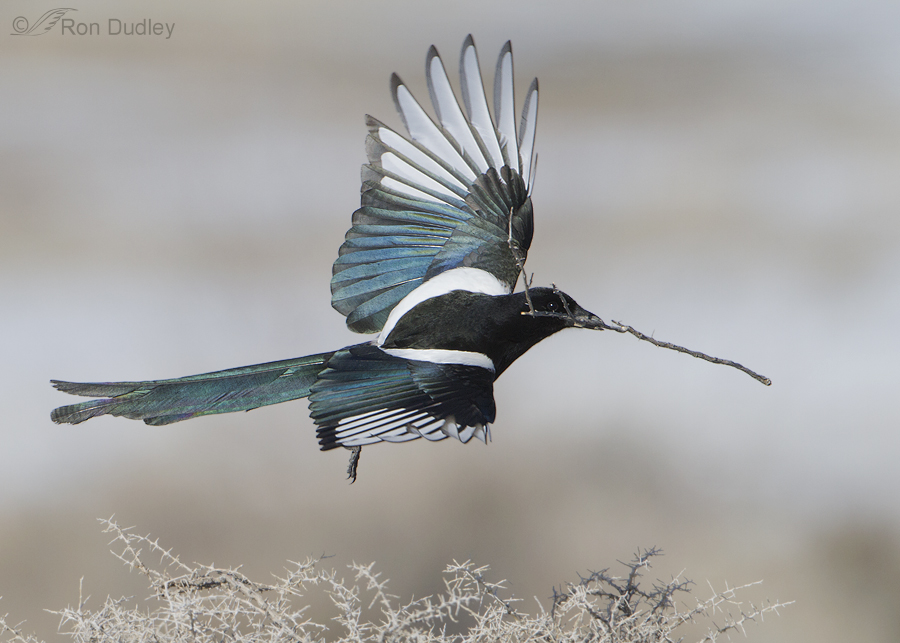
One of the reasons I like to see iridescence in Black-billed Magpies is that it brings out detail in those areas of the deep blacks where you normally don’t see any. Flight shots are inherently more difficult than static shots but ironically I find it easier to get the iridescence to show in flight than I do when they’re perched.
Black-billed Magpies Constructing Their Nest
This post is largely about behavior. The image quality ranges from good to mediocre but I think each photo contributes something to a better understanding of magpies. Black-billed Magpies begin nest-building as early as January and these particular birds have been at it for several weeks now. Actually, in this case it’s more a “remodel” than it is “new construction” since this nest has been used for at least the last three years. All of these photos have been taken this week, which accounts for the relatively bright snow and ice background in some of the shots. 1/2500, f/7.1, ISO 500, 500 f/4, natural light One of the first things you may notice is the fact that sometimes these Black-billed Magpies don’t seem to have black bills. Part of nest construction involves mud gathering and the drying mud on the bill can significantly alter the appearance of the bill. 1/2500, f/7.1, ISO 500, 500 f/4, natural light Both sexes contribute to nest construction and they’re quite industrious in their efforts. The size of the twigs they bring in is often impressive. 1/4000, f/7.1, ISO 500, 500 f/4, natural light The nest is buried deep in a greasewood bush at about eye level for me. Typically a bird bringing in construction material will land on a nearby perch and look over the nest for a few moments – seeming to plan placement of the twig and an approach path through the myriad of vertical greasewood stems that present significant obstacles to proper placement of such an unwieldy…
Magpie Nesting Season Has Begun
I’ve spent the last two mornings photographing Black-billed Magpies in the midst of nest construction. These birds often re-use old nests and this is at least the third year they have used the same one. Even when “recycling” the nest like this, weeks of work go in to refurbishing it – they bring in a completely new lining of grass, mud, rootlets and even bison fur. And they add an amazing number of new twigs to the basic structure. These are industrious birds! I’ve said before that this species is my most challenging avian photographic subject and that fact has been reinforced this week. There are several reasons for that, including: the deep black and bright white combination is hugely difficult to expose properly that aggravatingly long tail makes composition difficult and it is very easy to clip or cut off in action shots they close their nictitating membrane more than any other bird I’ve photographed and when they do its color is a blue-white which is almost shockingly apparent against the black head when they take off from an elevated perch they typically flap once and then fold their wings tightly against the body at exactly the moment when it’s easiest to get them in flight, resulting in what I call a “torpedo-bird” flight posture that is less than desirable the dark eye set against a black head makes it very difficult to get a good catch light in the eye In the last two days I’ve taken over 1200 shots of these magpies and about 95% of them were garbage, largely due…
Black-billed Magpie Iridescence
Black-billed Magpies are loud, flashy and conspicuous black and white birds. And they’re a challenge to photograph well because of the exposure difficulty – getting detail in the blacks without “blowing out” the whites. I probably discard a higher proportion of shots of this species than I do any other. But if you work hard at it (with a little luck thrown into the mix) you can get some pretty spectacular shots that have detail in the blacks and whites and their showy iridescence. The actual plumage of these birds is truly black and white, with no other colors. But in the right light the feather structure (and other factors) on the tail and wings of these birds bends the light much like a prism and produces a variety of colors, predominantly blues and greens. When I’m photographing magpies, one of my goals is usually to capture some of that iridescence. 1/4000, f/6.3, ISO 500, 100-400 @ 400mm, natural light Three days ago I found this magpie perched on a snow-covered boulder on Antelope Island. As you can see the whites are well-exposed but there’s not a lot of detail in the blacks. This is the type of magpie image that I normally wouldn’t do much with except for purposes such as this post (my high shutter speeds were due to the snow and the fact that I was attempting take-off shots). 1/4000, f/6.3, ISO 500, 100-400 @ 400mm, natural light This is the same bird on the same perch but the image was taken…
A Wonderful Antelope Island Morning – Including A Long-tailed Duck
It’s been a frustrating photography week for both Mia and I for a variety of reasons but it’s primarily been because the weather and light have seriously sucked – big time!. So when yesterday’s dawn showed promise we headed for the island with high hopes but low expectations because there haven’t been many bird opportunities out there recently. We were in for some pleasant surprises. I’ll present these images in the order they were taken to give a feel for the morning. 1/2500, f/7.1, ISO 500, 500 f/4, 1.4 tc We had barely made it onto the causeway before this Rough-legged hawk began to entertain us. We watched as it ate a vole and then it immediately walked about two feet to its left and picked something else up with its foot. At first I assumed it was another vole, either alive or from a food cache. But in looking at close-ups of some of the photos I’m pretty sure it’s only a rock with old brine fly larvae cases and small twigs frozen to it. Then this hawk did something strange – it transferred the “rock” to its beak and deliberately flung it a good distance – here it’s flying through the air Then the bird walked over, picked up the rock in its left foot and flew off with it. My curiosity is killing me as to just what was going on. Obviously this isn’t a great shot but I was fascinated by the behavior. 1/2000, f/7.1, ISO 500, 500 f/4, 1.4 tc Next this Northern Harrier gave us…
Just A Shot That I Like… #16 – Black-billed Magpie In Flight
Black-billed Magpies aren’t appreciated by everyone. Their raucous behavior and scavenging habits put some folks off but I’m quite fond of them for their relatively high intelligence and incredibly interesting behaviors (examples – they conduct ritualistic “funerals” of up to 40 birds around the dead bodies of other magpies and you haven’t lived until you’ve seen one tormenting a cat by repeatedly pulling its tail). That said, they’re very difficult photographic subjects. Their black plumage soaks in the light while the bright white feathers reflect nearly all of it so getting exposure and detail in the overall bird is incredibly challenging. I probably delete a higher percentage of images I take of magpies than I do of any other species I regularly photograph which makes getting an image I like especially rewarding . I enjoy meeting the challenge… 1/1250, f/8, ISO 500, 500 f/4 When the light’s at the right angle you can sometimes get impressive iridescence in the blacks which also helps to bring out some of the detail there. This bird had just taken off from the sagebrush that its nest is deeply buried in. And it was even considerate enough to give me a pleasing head turn and eye contact as it did so. I’ve photographed this bird and its mate at their nesting site for three years now (and yes I’m very careful not to disturb them). Can’t wait for early spring to try it again. Ron
Black-billed Magpie Nesting Behavior
This past spring and summer I had the opportunity to observe and photograph nesting behaviors of Black-billed Magpies on Antelope Island in northern Utah. Magpies are common in Utah and much of the western US but they’re typically difficult to approach (and very challenging to photograph well because of the contrast of their coal-black and almost pure white plumage) but this pair of birds was so intent on their nest-building activities that they virtually ignored my presence. Mated pair of Black-billed Magpies Magpies are monogamous and typically mate for life. This is a mated pair on top of their domed nest in a sagebrush. The male is on the left, the female on the right – males are about 20% larger than females so they are sexually dimorphic. As you can see from the muddy bill of the female they’ve been actively building the mud-bowl found inside the nest. Typically the male provides the heavier branches and sticks for the nest and the female delivers most of the mud for the mud bowl, which probably explains why the female’s bill is so muddy while the male’s is not. Obtaining mud for then nest The mud for the bowl of the nest was obtained wherever the birds could find it. When we’d had dry weather they would have to fly quite a distance to get any but after a recent rain they would often get it very close by. This bird has just scooped up a bill-full. When it’s available they’ll sometimes use fresh cattle or bison dung in place…


